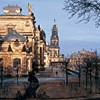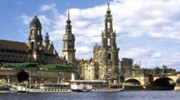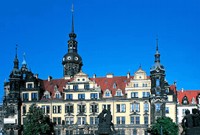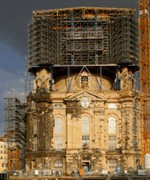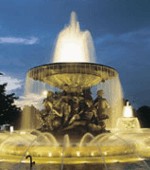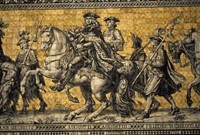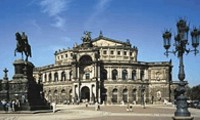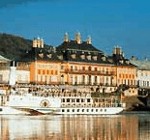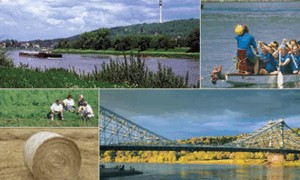|
Dresden
- the city of art and culture, the pearl
of the occident and the synonymous for an anglo-american holocaust. We
would like to introduce the city of Dresden to you on this page: History Founded
on the site of a fishing village as a merchants' settlement and the seat
of the local rulers, Dresden was from the 15th century onwards residence
of the Saxon dukes, electoral princes and later kings. The city has
experienced both splendid eras and times of tragedy. It was above all
during the 18th century a magnificent centre of European politics, culture
and economic development, only to become a synonym for apocalyptic
destruction just two centuries later. For the people of Dresden, and for
friends all over the world, it has always been a unique city, with a
fascination which has evolved throughout a turbulent history.
City
of art УDresden
gave me great pleasure, and my desire to think about art was revived.
There are unbelievable treasures of all kinds at this beautiful place.Ф This
positive rйsumй was given by no lesser person than Johann Wolfgang von
Goethe, after he had just spent his fourth stay in Dresden in 1794, during
which he made several visits to the city's art collections, and above all
to the famous Picture Gallery. On visits to his friend Christian Gottfried
Kцrner, Friedrich Schiller met many important contemporaries among the
former's wide circle of acquaintances and drew important inspiration for
his literary works. Just a few years later, Heinrich von Kleist was
equally enthusiastic about the city, its delightful setting, the slopes of
the Elbe valley and the Уpositively Italian skiesФ above. The
names of these three poets stand as representatives for countless famous
names in art, music, literature and science, for all those who were at
home in Dresden over the centuries and found stimulation in the creative
atmosphere in the city. Similar conclusions, albeit in more modern words,
are still today left behind by Dresden visitors who explore the city with
an attentive eye and who are receptive to the uniquely harmonious blend of
art, culture and natural beauty which makes up the special charm
of Dresden. Architecture
in Dresden The
residence of the Saxon electors and kings brought forth important
architectural gems over the whole period since the 16th century. This is
seen most clearly today in the Dresden Palace, for example, which presents
traces of practically every style period of European architecture.
Nevertheless, the contemporary fame of Dresden's architecture is founded
on its Baroque buildings. As Kings of Poland, Augustus the Strong and his
son Augustus III had Dresden transformed into one of the most exquisite
royal residences in Europe. Impressive testimonies to the Baroque period
are today still the Zwinger by Pцppelmann and Permoser, the Blockhaus,
the Taschenbergpalais, the Japanese Palais and George Bдhr's Frauenkirche
church. The Classicist years represented a second important zenith in the
city's development with Schinkel's guardhouse on Theaterplatz square,
alongside the art gallery and opera house by Gottfried Semper, which were
created in the style of Historicism. The
rapid growth of the city from the second half of the 19th century was not
only a period of important technical and urban planning achievements, but
also added further outstanding buildings into the Dresden townscape. The
city was thus able to maintain its already famous townscape, while at the
same time introducing innovative architecture. Hans Erlwein, for example,
created a series of pioneering municipal buildings, and the district of
Hellerau was the first "garden town" in Germany. The
severe destruction at the end of the Second World War robbed Dresden of
many of its architectural monuments. In the meantime, however, endlessly
painstaking work, under the supervision of committed and expert monument
curators, has succeeded in restoring the city's reputation as a pearl of
European architecture. The
historic centre of the city on the River Elbe should be explored on foot -
from the Zwinger and the Semper Opera House to the Royal Palace, which is
under reconstruction, on to the Frauenkirche and to Brьhl's Terrace, and
to the town houses in the inner new city (Innere Neustadt).
The
fine arts have enjoyed a long tradition in Dresden. Even back into the
Middle Ages, important artists of the time were active in Dresden with
commissions from the Saxon court. Dresden
enjoyed an outstanding heyday in the 18th century under the rule of
Augustus the Strong and his son Augustus III, who transformed their
residence into one of the most magnificent cities in Europe. Architecture,
art and music experienced a significant upswing during the so-called
"Augustan age". Both monarchs attracted eminent artists to their
courts: The portraits by French painter Louis de Silvestre have left us
impressive depictions of the Saxon-Polish rulers, while court jeweller
Johann Melchior Dinglinger created breathtaking works of art of previously
unknown beauty and
preciousness. After
countless unsuccessful experiments, Johann Friedrich Bцttger discovered
the recipe for European porcelain, the legendary "white gold" of
Saxony, and the famous bell- shaped dome of George Bдhr's Frauenkirche
overlooked the city from 1743 onwards. The year 1755 saw publication in
Dresden of Johann Joachim Winckelmann's controversial essay УThoughts on
the Imitation of Greek Works in Painting and SculptureФ, in which he
propagated a renunciation of the courtly formal language of the Rococo
style and inaugurated the epoch of Classicism. The
Dresden Art Academy acquired considerable importance in the second half of
the century. Such prominent professors as Anton Graff and Adrian Zingg
made the Dresden Academy one of the most important art schools in Europe
in the field of painting.
In the mid-19th century, Ernst Rietschel, Gottfried Semper and Ludwig
Richter
rang in a second significant era for the Academy, which experienced a
further zenith around the turn of the century with artists such as
Gotthardt Kuehl and Robert Sterl. The
Electors and Kings of Saxony were enthusiastic collectors of art and
acquired art treasures of immeasurable value over the course of the
centuries. With his Electoral collection of cabinet pieces, Elector
Augustus laid the foundation for the original collection in Dresden, which
was counted among the most remarkable sights in Europe as early
as the 17th century. So
rapidly did the collectibles grow in number and variety that special
museums were founded as long ago as the 18th century. Thanks to the
collections, state-owned since 1924, Dresden is one of the most important
museum cities in Europe today. The
best-known museum of the Staatliche Kunstsammlungen Dresden is certainly
the Old Masters Picture Gallery
in the Semper museum building adjoining the Zwinger, where the most famous
painting is Raffael's Sistine Madonna. The New Masters Picture Gallery in
the Albertinum building on Brьhl's
Terrace holds important works from the Romantic period to the present day.
The
same museum building currently also houses the Grьnes Gewцlbe (Green
Vault), the widely known, most valuable German collection of more than
3,000 works of applied arts. The subjects of the 37 Dresden museums range
from civic history to military history, from the Technical Collections
(Technische Sammlungen) to the Book Museum.
The
history of court music in Dresden can be followed back at least as far as
the 15th century. The "Hofcantorey" choir and orchestra founded
in 1548 started up a tradition continued today by the Staatskapelle
orchestra and the Saxon State Opera Company. In
the 17th century, Heinrich Schьtz (1585-1672) raised Dresden's court
music to European significance. He is considered the "father of
German music", wrote the first German oratorios, as well as numerous
religious concerts, Passions and motets. These works are still fostered
today, for example by one of the oldest and most famous boys choirs in the
world, the Dresden Kreuzchor choir. From
1734 to 1763, Italian opera enjoyed a unique heyday under Johann Adolf
Hasse, who created around 100 musical works here. In the 19th century,
Carl Maria von Weber established Dresden as a centre of Romantic music,
Richard Wagner composed his "Tannhдuser" and
"Lohengrin", and Robert Schumann experienced his most creative
period in Dresden. Around the turn of the century, the
Dresden opera house contributed once more to musical history, for example
with the premieres of nine operas by Richard Strauss. Dresden
is the home of important orchestras, such as the Staatskapelle and the
Dresden Philharmonic. In the Dresden Semper Opera House, one of the most
famous opera houses in the world,
audiences can enjoy a unique blend of tradition and contemporary music
culture. The
Staatskapelle orchestra is one of the leading orchestras in the world and
occupies a prominent place in the musical life of the city. With its 145
musicians, it not only accompanies productions of the State Opera Company,
but also maintains its own extensive concert calendar. The Dresden
Philharmonic, the second world-class orchestra at home in Dresden, devotes
its activities not only to regular concerts and tours, both at home and
abroad, but also to intensive Theatre
in Dresden Regular
performances by travelling theatre groups in Dresden
are documented back into the 16th century. On occasions they also played
for the Saxon court, though it was opera which dominated here. In the 18th
century, Caroline Neuber, the "mother of German theatre", worked
in Dresden. In the first half of the 19th century, the State Theatre
founded in 1814 was the determining factor in the city's theatre scene,
with directors such as Ludwig Tieck and Karl Gutzkow. Further highlights
in Dresden's theatre
history were
the performances of works by contemporary dramatists such as Ibsen,
Strindberg, Wilde and Schnitzler
around 1900.
Literature
in Dresden The
special atmosphere in the city - characterised by the apparent
contradictions of the dreamy, almost conventional lifestyle of a royal
residence on the one hand and a creative, cosmopolitan cultural centre on
the other - has attracted and inspired countless poets and friends of
literature over the centuries. At
the end of the 18th and beginning of the 19th centuries, Dresden became
one of the centres of German literature, especially for the Romantic
movement. The salons held by Christian Gottfried Kцrner, and later the
house of Ludwig Tieck, were popular meeting places for great poets such as
Goethe, Schiller, Herder, Kleist and Novalis and important philosophers
such as Humboldt and the Schlegel brothers. The surroundings of Dresden are also very beautiful, Saxon Switzerland or the old town of Meiяen so for example. Via 7,4 million visitors come every year to Dresden.
We
love our town and we are happy also on your visit!
|

